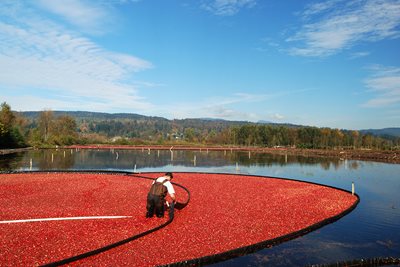In today’s blog we’re revisiting a favorite topic of ours, statistical process control (SPC), this time with guest Ian Farrell, Quality Manager for Ocean Spray Cranberries, Inc. in the Pacific Northwest. He’s a proponent of using SPC in manufacturing and has been using InfinityQS quality management software for a while now.
Statistical Process Control is near and dear to our hearts because it’s at the root of all we do here at InfinityQS. With the right SPC software solution, the data you are already collecting can provide so much more—actionable information about process performance, product quality, and product consistency. Ian sees the benefits of SPC every day on the plant floor. But getting your operators to buy into your SPC software is important…and sometimes not so easy. He has some insight into how to show your operators the importance and benefits of SPC—without a slide rule, without math, and with a smile.
In Quality Manufacturing, Numbers Matter
Ian is a self-proclaimed “numbers person” who works in a quality assurance role. We believe that his role represents many of our readers—people who appreciate the statistical method, the scientific edge it can give your business, and above all the path it takes you on to continuous quality improvement.
Like many of us, Ian is always working toward “making product better, for less money.” He enthusiastically adds, “let’s reduce waste where we can; let’s improve yield where we can.” He says that it’s really the objectivity of data that appeals to him. Not guessing; more than simply “having a feeling” about things. “Data wins every time…statistics are not really debatable,” he says.
And that is precisely why he uses an InfinityQS quality management solution. When he finds ways in which to improve his operations, with SPC data behind him, he always has a strong case.

To-Target Rather than In-Spec with SPC
According to Ian, his plant floor traditionally worked to specification limits. In-spec product was good enough. “Before we used SPC for real, we used InfinityQS software as more of an archival tool. But we had our spec limits in there, so the tool basically told us when we were in-spec or out-of-spec. That was pretty much it.” But the operators knew that anyway. They’re what InfinityQS COO Doug Fair would call “operator-artists” who know their machines inside and out. (See more about this topic in his blog.)
Anyway, Ian used SPC to point out that what they needed to focus on was running to-target. That’s an important distinction, he says. “Running to-target vs running in-spec is a key component of giving the customer the best experience possible.” But there’s more to it. He adds, “If you’re above target (but still in-spec), you’re actually adding more ingredients than you need to and so that product now costs more than it needs to.” Enter the quality team.
By tracking the process using SPC analysis on a daily basis, and reviewing the data with the management team, Ian found that they could tweak the process to be more to target and produce a better end result. “And we could save money every month.” That’s a win-win if ever there was one.

How Do You Get the Buy-In You Need?
An important part of using SPC, he says, is getting buy-in from your operators. They do the real work on the plant floor. And their acceptance, and eventual buy-in, of SPC is what separates a so-so solution from one that really makes a difference.
Change Can Be Alarming
Operators did not see the benefit right away. Some weren’t convinced it worked; others didn’t trust the numbers; some thought it was just extra work. These are common responses to introducing a new way of doing things. Change is difficult. It simply takes time.
However, when you get an SPC alarm, that changes things. An operator then has proof that something is off and they need to go and make a change…or at least have a closer look.
Getting operators’ trust is not an instantaneous thing. It took Ian’s team a little while to become more familiar with alarms and metrics and all the good stuff that SPC entails. He adds, though, that over a fairly short period of time operators got more familiar with what the software could do for them. “Process capability goes up as the number of alarms goes down.” Sounds pretty good, right?

Training Shifts the Balance
So, Ian and his team got the operators used to the concepts of SPC. They then turned their focus to training. Part of his team wanted to go with a deeper level of training, “because operators want to understand what the calculations are and how to calculate a control limit.” But Ian wasn’t convinced.
“They don’t really need to know that,” he insisted. “The software does that for them.” What he was referring to was the old paper and pencil and slide rule days of SPC. Ancient history. InfinityQS quality management software does all that for you, like he says, and he’s right. The operators had no interest in the “nuts and bolts.“
What operators want is software that makes their jobs easier. Operators, as we all know, have a lot to worry about. Why add math and calculations to that? What is it that they really want to know?
What they really want to know, Ian discovered, is the essentials. “Understanding we do better when we’re running to target. That when an alarm occurs we’re (Ian’s quality team) going to be out there helping them make a decision on what to do about it. They [the operators] will be involved, of course, but it’s important that they know they’re not alone. We’re going to work on it together.”
And everybody learns from it. The bottom line is that the operator’s job is harder when things are out-of-spec or off-target. “There’s more work to be done. If you can keep things running to target, you’ve accomplished goal number one for operator buy-in: their job is easier.”
Make Training Fun

Convinced that the method of training would make a difference, Ian and his team brainstormed on ways to make SPC less about math and calculations and more about easy-to-grasp concepts. They came up with a great solution. “So, we did a fun thing with miniature golf. It was the first thing we did that had an SPC focus.” Here it is in a nutshell:
- Putting green, 10 or 15 feet
- Green, yellow, and red markers by the cup to mimic what a controlled chart looks like (X bar or IX chart)
- 5 golf balls
So, “golfers” putt the balls and someone then plots their accuracy. Where’d they end up? Were they to the left? In the red? In the yellow? “Okay, you didn’t hit all of them in the hole. That’s to be expected, right? Because each shot on some microscopic level is a little different from the last one and nobody hits it in the hole every single time…so that is common cause variation.” And that becomes the baseline.
Special Cause Variation Can Be Fun
So, then they set up some challenges to represent problems with the production line. “We put a fan blowing perpendicular to the course. They start by correcting for it. By the end, they get a few balls kind of close. First shots are terrible, though.” What that’s meant to represent is a piece of malfunctioning equipment. The golfers corrected for this special cause variation—but did not fix the problem. They just sort of lived with it. (What they could have done is turn off the fan; but no one thought of that.)
But even with that compensation, their variation is greater than it was when there was no fan. “And so that’s a special cause variation that we can work on, and the InfinityQS software will detect.”
So, next they turned the fan off and handed the golfers a set of safety goggles—covered with layers of tape. This exercise represents bad data. “They could barely see the ball through the goggles, and they hit the ball that way…and they’re results were all over the place.” As you can well imagine. Now Ian is smiling; it’s easy to see that this was kind of fun.
“Maybe your laboratory equipment is faulty and giving you bad readings, which are, in turn, causing you to make bad processing decisions.” In summary, that adds another special cause variation for which you need to adjust. “You need to find that cause and fix it,” he says. Easy. Remove the goggles, right?
So, when they take off the goggles Ian and his team give them another challenge: non-round balls to try. “This,” he says, “represents bad or inconsistent raw materials.“ Okay, this sounds like torture now. Ha!
“These balls roll and bounce all over the place.” Again, special cause variation. They would discuss with the golfers how that can be fixed. “If this were production, we’d put those raw materials on hold, change to a new batch that is in-spec [he says as they hand over nice round golf balls], and everything should return to normal.”
It all makes sense, and they had a little fun with it. SPC isn’t so bad, is it?
Lessons Learned
So, then Ian and his team tie it all back together. “We can fix all these variations with SPC. The alarms are going to go off when you’re running under these conditions. But that baseline amount of common cause variation isn’t going to be detected by SPC. It shouldn’t be detected by SPC and you shouldn’t react to it. So, my advice to operators is this: Don’t see little variations and think that you need to have a flat line; you’re just never going to get there. It’s the big ones that you need to worry about.”
This brings it back to earth for the operators. They can be at ease knowing that the expectation is not that every test needs to be at target; it’s understood that there’ll be some common cause variation. It’s not a reflection of how the operator is performing his/her duties. “It’s there for everybody. It’s there for everybody’s golf swing and it’s there for everybody’s turn at the production line.”
“So, it was good to draw that distinction because I think a lot of times everybody thinks that all variation is bad, and it’s all from the same place, and it’s all fixable—and none of those things are true.”

Closing
You can see how making the “training” fun can make SPC more relatable for operators. Honestly, they have enough on their plates without adding math or calculations. But, as you can guess, the training did not end here. Ian had some more fun challenges in store to bring SPC to his operators. You can read all about them in depth in the case study we wrote up about his experience with InfinityQS quality management software.
For your production processes, consistency in both quality and consumer experience is critical. It certainly is for Ian and his team. You, too, can find that InfinityQS quality management solutions are here to help make your use of SPC a positive experience that leads to continuous improvement, reduced costs, and actionable information you can use to make strategic decisions that can transform your business.
Take advantage of the technology at your fingertips today: contact one of our account managers (1.800.772.7978 or via our website) for more information.
Learn more about our quality management systems, Enact® and ProFicient™.